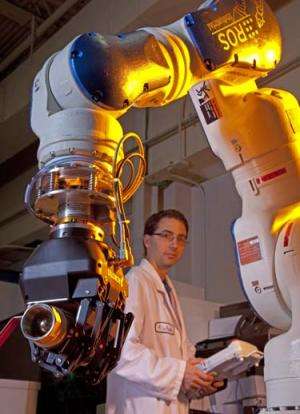SwRI launches Robot Operating System-Industrial Consortium

Southwest Research Institute (SwRI) is launching a cooperative research consortium to accelerate the development of ROS-Industrial, an open-source extension of ROS focused on the needs of industrial users.
ROS, which stands for Robot Operating System, is an open-source project providing a common framework of libraries and tools for a wide range of applications, particularly for service and research robots. The ROS-Industrial Consortium (RIC) will enable the industrial robotics community to apply the advanced capabilities of ROS for industrial applications quickly and easily using a common platform, the ROS-Industrial open source software program. The consortium will conduct foundational, precompetitive research and code development at the direction of the membership. Test results, data, recommendations and analysis generated by RIC will create a competitive advantage for its members and will be protected from public disclosure for a period of time.
"Consortium members will have access to practical user services, including technical support and training, to foster the use of ROS-Industrial by industry," said Paul Evans, director of SwRI's Manufacturing Systems Department. "Another benefit: The membership will be driving the RIC research program, collectively deciding development priorities to meet members' most critical needs."
"Southwest Research Institute founded the ROS-Industrial repository in January of this year, with support from Willow Garage and Motoman Robotics, to bring advanced robotics software to the industrial automation domain," explained Shaun Edwards, a senior research engineer in SwRI's Automation and Data Systems Division.
"Building on the software libraries that ROS provides, ROS-Industrial will enable advanced capabilities and interoperability with a range of off-the-shelf industrial mobile platforms, manipulators, perception systems, and peripherals, without sacrificing the reliability and safety crucial for industrial systems," said Edwards.
To date, ROS-Industrial has demonstrated capabilities unmatched using conventional industrial robot control for applications such as material handling in dynamic environments with on-the-fly object segmentation and grasp planning. Standard interfaces allow high-level software to work with any robot. ROS-Industrial supports robotic workcell visualization and simulation capabilities such as RViz, allowing system development and testing with or without physical hardware.
ROS-Industrial allows device access over various wireless networks and advanced 2D-vision and 3D-point cloud sensor processing. Rich software development tools (based on standard Linux tools) include universal logging, debuggers and automated coding. Multiple robot path planners and optimizations allow developers to choose and customize systems that support high-degree-of-freedom systems coordinating multiple arms.
The consortium will accelerate the adoption of ROS-Industrial by allowing the user community to address its current problems and future applications. ROS-Industrial will create code quality standards indicative of an industrial software product, to include rating/tracking code quality metrics, multi-level testing and documentation.
Provided by Southwest Research Institute





















